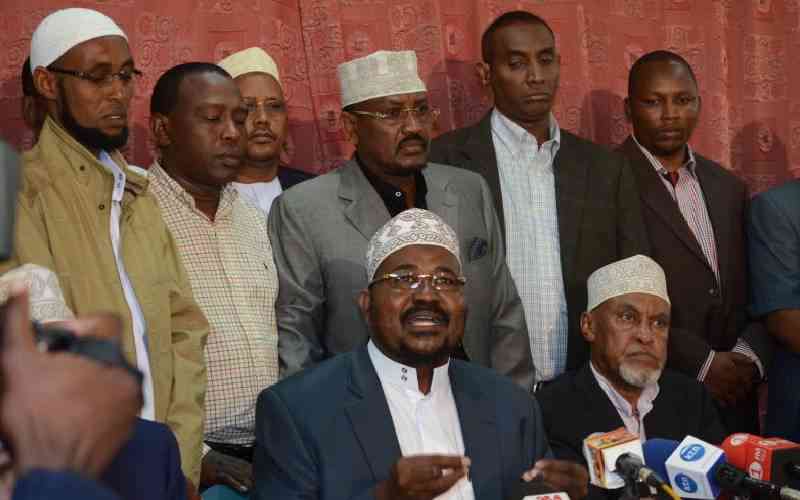The worrying state of insecurity especially in Northern Kenya – Garissa, Isiolo, Wajir and Mandera among other places – is obviously a major national concern.
Although the government has opted to construct a wall to deter illegal immigrants and terrorists finding easy entry into the country, the continued reported cases of attempted terrorist attacks on innocent Kenyans and on our soldiers raise fears that the devil is still within.
One cannot pretend that there are easy options on how to defeat an enemy using very unorthodox and unconventional strategies of war. Regardless of the amount of fear that the terrorists want to instill in us, our resolution must remain one of finding safety and peace.
Considering the expansiveness of Northern Kenya and the huge sums of monies needed to secure peace and draw focus to developing the otherwise largely marginalised part of Kenya by previous regimes, the governments – national and counties – should consider clustered settlements as a not-so-easy yet a viable option of protecting the area residents.
The inhabitants of Northern Kenya largely live in quasi-clustered settlements based on clans and tribes. They migrate and traverse the region mainly in search of water.
Traditionally, some of the conflicts in the region are triggered by the struggle for water.
Often, during drought seasons Northern Kenya becomes one large disaster zone threatened by hunger, diseases, and loss of animals, the economic base for the residents.
Moreover, over the years, relief agencies and religious organisations have become part and parcel of the sustainability mechanism for the people of the region.
In addition, insecurity, a new phenomenon only adds to the misery of the people in Northern Kenya.
Specifically, the people of Mandera and Wajir have constantly suffered insecurity in the quiet of the desert breeze. Being closer to Somalia does not offer any advantage. Needless to say, the contrary is the case.
I therefore think that the government should consider clustering settlements in a manner that all residents live in select places where all services can easily be consolidated.
In a county, there should be designated residential areas to which everyone should move and from where everyone should operate for everyday sustenance.
In clustered settlements governments will be able to not only offer the much needed security to the extent that this is possible but also governments' services such as provision of water will be relatively easier to provide.
For instance, providing a water pipe for 1,000 people who live about 50km apart is much more difficult than offering the same service to 10,000 people living together.
Providing security for people whose perimeter is easier to determine is more practical than working to protect people who live several miles apart, with no electricity to enhance security, no regular roads, no functional phone system, no emergency posts close to people and even more challenging, no stable settlements.
Stay informed. Subscribe to our newsletter
Similar government services such as education and health provisions will be easier to deliver in clustered settlements than is today. To respond to a serious sick call, for instance, in a semi arid, sparsely populated and generally abandoned environment because of the low infrastructural development is a concern that not even devolution will tackle any time soon.
Yet, with an open mind and a bit of collective effort, enhancing security and government support to the people of Northern Kenya can be done better through clustered settlements. There is no doubt that clustered settlements have their own weaknesses.
This proposal is, in part, therefore, a no brainer. The failure of the Ujamaa (socialism) villages in Tanzania is a case in point. Moreover, the rich and those who have power, may not want to live in clustered settlements.
However, it is important to emphasize that the idea proposed here is not in the philosophy of the Ujamaa model. It is the city-like model where several people live in one flat even when they do not know each other. Services are provided cost-effectively.
More examples are necessary. People who pluck tea in Kericho estates live in one clustered settlement yet have autonomous lives. Each individual earns their day.
In Hong Kong, there are flats as high as over 50 stories that house several hundreds of people.
Of utmost importance in saving lives in Northern Kenya as is in the whole country is improved security. A huge chunk of the money the 2015/16 budget has, thankfully, been allocated to security.
Can this money be used to construct secure clustered settlements for people of Northern Kenya?
 The Standard Group Plc is a
multi-media organization with investments in media platforms spanning newspaper
print operations, television, radio broadcasting, digital and online services. The
Standard Group is recognized as a leading multi-media house in Kenya with a key
influence in matters of national and international interest.
The Standard Group Plc is a
multi-media organization with investments in media platforms spanning newspaper
print operations, television, radio broadcasting, digital and online services. The
Standard Group is recognized as a leading multi-media house in Kenya with a key
influence in matters of national and international interest.
 The Standard Group Plc is a
multi-media organization with investments in media platforms spanning newspaper
print operations, television, radio broadcasting, digital and online services. The
Standard Group is recognized as a leading multi-media house in Kenya with a key
influence in matters of national and international interest.
The Standard Group Plc is a
multi-media organization with investments in media platforms spanning newspaper
print operations, television, radio broadcasting, digital and online services. The
Standard Group is recognized as a leading multi-media house in Kenya with a key
influence in matters of national and international interest.









